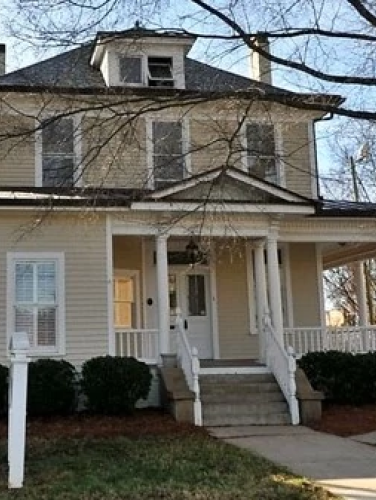
R. C. Biberstein House
(ca. 1906)
The prolific mill architect Richard C. Biberstein skillfully adopted the Rectilinear architectural style to design his family home.
1600 Elizabeth Ave, Charlotte, NC 28204
Noted mill architect Richard C. Biberstein (1859-1931), reputed to have designed more cotton mills in this region than any other individual, also designed the home that his family moved into in 1906, which they maintained for nearly a century. The house, an impressive example of the Rectilinear architectural style, is believed to have been his only residential design.
Property Quick Links
Born in the German settlement of Fredericksburg, Texas, Biberstein studied mechanical engineering at Worcester (Massachusetts) Polytechnic Institute, graduating in 1882. After employment with the U.S. Electric Lighting Company of Newark, New Jersey, the Western Manufacturing Company in Richmond, Indiana, and the Atlas Engine Works in Indianapolis, he made the acquaintance of Colonel John Wilkes, owner of the Mecklenburg Iron Works, during a brief visit to Charlotte. He returned to begin work for Wilkes in 1887 as a draftsman-designer. Some ten years later, Biberstein went to work for the Charlotte Machine Company, a mill machinery supplier run by Hubert S. Chadwick. In or about 1902, Biberstein moved again, leaving Chadwick's employ to work as an engineer for Stuart W. Cramer, whose company designed and built many mills in the region (including Charlotte’s Highland Park #3).
Finally, in 1905, Biberstein went into business for himself as a mill architect and engineer with offices in the Piedmont Building on Tryon Street. That same year he bought a parcel of land on Elizabeth Avenue for $1,250 from the Highland Park Company, the developer of the Elizabeth neighborhood, Charlotte's second streetcar suburb. When completed, the R. C. Biberstein House was situated on one of the city's finest suburban residential streets within easy reach of the city center. Sometime about 1915, while World War I was raging in Europe, Biberstein gave up his downtown office, moving it into the back of the first floor of his Elizabeth home where he continued to practice mill architecture until his death in 1931. Among the regional mills Biberstein designed were the Boger and Crawford Spinning Mill in Lincoln County; the Hudson Cotton Mill and the Dixon Mills in Gaston County; the Imperial Yarn Mill, the Linford Spinning Mill, and the National and Chronicle Yarn Mills in Belmont; the Union Cotton Mill in Mount Holly; the Mooresville Cotton Mills in Mooresville; and the Lancaster Cotton Mill in Lancaster, South Carolina.
When Biberstein died in 1931, his architecture firm – which continued to operate into the early twenty-first century under the name Biberstein, Bowles, Meacham and Reed – was taken over by his son Herman V. Biberstein (1893-1966), a 1914 N.C. State graduate who had joined the firm after college and Army service.

